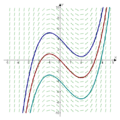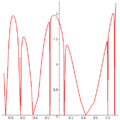Antiderivative facts for kids
Antidifferentiation, also known as indefinite integration, is a cool math process. It helps us find a special type of function in calculus. Think of it as the exact opposite of differentiation. When you do antidifferentiation, you start with one function. Then you find another function (or a group of functions) called an antiderivative. It's a lot like integration, but without specific 'limits' or boundaries. That's why it's called 'indefinite' integration.
In math, antiderivatives are often shown using capital letters like  or
or  .
.
What the Symbols Mean
When you see an antiderivative, it usually looks like this:  . Let's break down what each part means:
. Let's break down what each part means:
- The long, curvy 'S' symbol,
 , is called the integral sign. When you do regular integration, this sign often has numbers on it. These numbers tell you how to do the integration over a specific range. But for antiderivatives, there are no numbers on the integral sign.
, is called the integral sign. When you do regular integration, this sign often has numbers on it. These numbers tell you how to do the integration over a specific range. But for antiderivatives, there are no numbers on the integral sign. - The
 part is the function you are working with. This is the function you want to find the antiderivative of.
part is the function you are working with. This is the function you want to find the antiderivative of. - The letters
 mean "with respect to
mean "with respect to  ". This tells you which variable you are doing the antidifferentiation for. It's like saying, "We are doing this math operation based on the variable
". This tells you which variable you are doing the antidifferentiation for. It's like saying, "We are doing this math operation based on the variable  ."
."
Why is it Useful?
Antidifferentiation is super important in many areas of math and science. For example, if you know how fast something is moving (its velocity), you can use antidifferentiation to figure out its position over time. If you know how a population is changing, you can use it to predict the total population. It helps us solve problems where we know the rate of change and want to find the original amount.
Related pages
Images for kids
See also
 In Spanish: Integración indefinida para niños
In Spanish: Integración indefinida para niños




